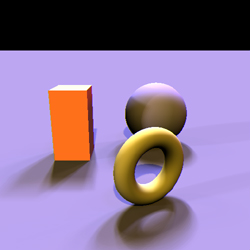
Abstract: This paper addresses the problem of efficiently calculating shadows from environment maps. Since accurate rendering of shadows from environment maps requires hundreds of lights, the expensive computation is determining visibility from each pixel to each light direction, such as by ray-tracing. We show that coherence in both spatial and angular domains can be used to reduce the number of shadow rays that need to be traced. Specifically, we use a coarse-to-fine evaluation of the image, predicting visibility by reusing visibility calculations from four nearby pixels that have already been evaluated. This simple method allows us to explicitly mark regions of uncertainty in the prediction. By only tracing rays in these and neighboring directions, we are able to reduce the number of shadow rays traced by up to a factor of 20 while maintaining error rates below 0.01%. For many scenes, our algorithm can add shadowing from hundreds of lights at twice the cost of rendering without shadows.
| The paper | A pdf of the paper to appear in JGT | 1.3MB |
| A 36in x 48in poster | from SIGGRAPH 2004 Poster Session | 1.7MB |
| Bunny animation, OPT | An animation of the Bunny scene, computed with OPT, showing the sampled environment (~400 lights) being rotated. | ~12MB |
| Plant animation, OPT | An animation of the Plant scene, computed with OPT, showing the sampled environment (~400 lights) being rotated. | ~38MB |
| Plant animation, TRUE | The same animation of the Plant scene, computed with TRUE. The high frequency shadows cause the leaves to shimmer during the animation. Here, we can see that this is not a result of the CBVS algorithm. | ~38MB |
| Shapes animation, OPT | An animation of the Shapes scene, computed with OPT, showing the sampled environment (~400 lights) being rotated. | ~12MB |
| Shapes animation, OPT_FLO | An animation of the Shapes scene, computed with OPT but the flooding restrictions are performed at the Finest Level Only. This removes the incorrectly filled shadow of the torus noticeable in the OPT animation. The performance of this method is roughly 25% worse than OPT | ~3MB |
| VisView | This package contains code and executable for the visualization tool used to explore the methods dexcribed in the paper. (comes with only 1 sample data-set). The fastest way to start using VisView is to unzip this .zip file and open visview.exe in teh Debug directory. Alternetavly, use one of the datasets below that comes with command-line arguments (copy visview.exe into the same direcotyr as the other files in the data-sets). | ~5MB |
| CBVS data-sets | This package contains the data needed by VisView. It also explains how to generate data for new scenes, and contains a batch file with command-line arguments to recreate all the figures in the paper. | ~127MB |
| CBVS data-set for Figure 6 only | Same as the above package, but only has support for Figure 6 of the paper. | ~10MB |